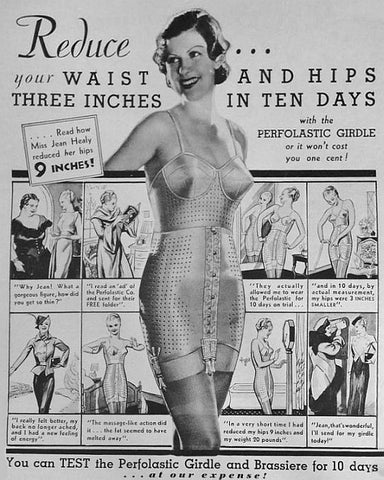We recently read about rubber corsets while flicking through 'Support and Seduction: The History of Corsets and Bras' (1997) by Beatrice Fontanel. After reading a little more online, we jotted down the following notes about the sweaty garments.

It became possible to create fine rubber yarn in the 1930s which was combined with rayon and cotton to create a two way stretch fabric. The Charnaux Company create a perforated rubber corset that could be pulled on over the body, the perforations allowing greater elasticity and providing some much needed ventilation. A smooth silhouette became achievable without the need for lacing or boning while also allowing a greater freedom of movement.

Alfred Hitchcock's "39 Steps" (1935) shows two travelling salesman admiring the latest in corsetry; the rubber Charnaux girdle.

Rubber bras were made to be worn with the girdle and marketing teams capitalized on the revolutionary departure from the stiff corsets a young woman’s mother might have worn. Advertisements also claimed that the undergarment would not only seamlessly smooth you out but actually cause you to shed pounds. Was this because it made you sweat so much?! As the 30s went on, the term ‘rubber’ fell out of favour and marketers coined other names for the material used in ‘reducing garments’ like ‘slymlastik’. One Slymlastik ad explained the weight loss properties with the following copy: “The large perforations form minute suction cups which work constantly, gently but persuasively eliminating fat".

When WWII kicked in, rubber was diverted for use in other industries. The Playtex company revived rubber corsetry after the war. Their marketing in the post-war era was influential in creating the shift from custom-tailored undergarments to manufactured sizes.

Besides the discomfort of sweating in a rubber undergarment, these girdles and panty girdles could also split at inopportune moments. Playtex sold their girdles in tubes and the garments often decomposed to a sticky mess with time. They could also become rigid and crack with age, splitting along the perforations. Not to mention the chemical odour.

They actually continued to be produced as late as the 1970s. Not many have survived to the present day as rubber naturally degrades, especially when in contact with perspiration. The modern day equivalent would be latex fetish wear.
Pictured are various advertisements for rubber girdles! Check out Corsetiere.net for more!
